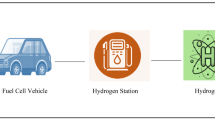Abstract
Compilation and implementation of green productivity mechanism in each governmental and nongovernmental organization has several environmental, social and economic achievements.In this paper for management of green productivity in Iran Aseman Airline Company current situation are analyzed such as the consumption of energy, water, airplanes fuel and evaluating environmental pollutants. At the end of this study some applicable techniques for increasing the productivity and consideration of environmental aspects in this company are recommended. Maximum water consumption had been 7500 m3 in the year 2005 during August until September, the maximum of electricity consumption was 759300 kWh in the year 2004 during July until August, the maximum of natural gas consumption had been 83647 m3 in the year 2004 during Feb until March, Also averages of 661500 L of fuel were consumed in this company’s vehicles yearly and in the last nine month of the year 2005, amount of 60263155 liters of airplane fuel has been consumed.
Similar content being viewed by others
References
Thames, R., (2005). Aircraft Noise Survey, London Borough Publications, 2–5.
Department for Transport, (2003), Aviation and the Environment Using Economic Instrument, Great Minster House, London, 28–31.
Informative Department of Green Management system, (2005). Informative Magazine, Green Government secretarial, Department of Environment Publications. (9), 11–16.
Department of the Environment, (2003), Gideline for execution of Green management system for industrial division, Iran Expertise Group, Quality and Management Publication, 3–36.
Jeppesen, E. (2000), International Standard Book, Airline Transport Rating Course, published simultaneously in Germany.
Kim, I., Hur, T., (2004). An attempt to measure green productivity, Department of Material Chemistry and Engineering, Konkuk University, Seoul,Korea, 1–3.
Pineda, R., (2004). Developing an Expert System for GP Implementation, Department of Industrial Engineering, Hloy Angel University, Angeles city, Philippines, 2–3.
Schiling, D., (1997), Modeling Aircraft Fuel Consumption with A Natural Network, M.sc Thesis in Civil engineering to the faculty of the Virginia Polytechnic Institute and State University, 23–28.
Whitelegg, J., Cambridge, H., (2004). Aviation and Sustainability, Stockholm Environment Institute, 21–25.
Wheat, J., (2003). Washing of Aircraft at Tampa International Airport, Hillsborough County, Aviation Authority.
Meredith, J., (2005). Aviation and the Environment, Air transport action group, 10–19.
Omrani, G., (1995). Solid Waste, Islamic Azad University Publication Center, 10–13.
Li, X.D., Lee, S.C., Poon, C.S., Chung, S.S., Luk, F., (2003). Waste reduction and recycling strategies for the in flight services in the airline industry, Resources, Conservation and Recycling, 3(2), 87–99.
Author information
Authors and Affiliations
Corresponding author
Rights and permissions
About this article
Cite this article
Moharamnejad, N., Azarkamand, S. Implementation of green productivity management in airline industry. Int. J. Environ. Sci. Technol. 4, 151–158 (2007). https://doi.org/10.1007/BF03325973
Received:
Revised:
Accepted:
Published:
Issue Date:
DOI: https://doi.org/10.1007/BF03325973




